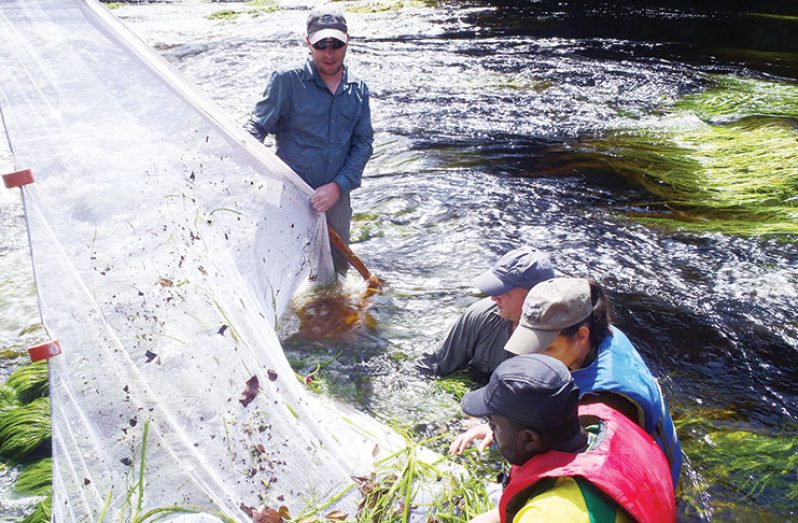 HELLO readers, with the International Day for Biological Diversity, another major day on the environmental calendar, on the horizon, this week’s article will focus on the Application Process for Biodiversity Research in Guyana. One of the functions of the Environmental Protection Agency is to protect and conserve Guyana’s natural resources, inclusive of its rich biodiversity.
HELLO readers, with the International Day for Biological Diversity, another major day on the environmental calendar, on the horizon, this week’s article will focus on the Application Process for Biodiversity Research in Guyana. One of the functions of the Environmental Protection Agency is to protect and conserve Guyana’s natural resources, inclusive of its rich biodiversity.
This is necessary to ensure these resources and the information collected are used and shared in a manner to promote Guyana’s green development agenda.
Most persons are captivated by the fascinating videos and documentaries which reflect the intriguing and exotic plants and animals of Guyana. I’m sure you would agree that important to protecting and conserving what we have, is knowing what we have and the value of it. Therefore, to address this issue, the EPA has developed a National Biodiversity Strategy and Action Plan (NBSAP 2012-2020). This document captures status and trends in biodiversity as well as the mechanisms to ensure adequate management and protection.
HOW DO WE KNOW WHAT EXISTS?
Research, as one of the priority areas in the National Biodiversity Action Plan, will generate data on Guyana’s biological resources to ensure effective management. The EPA is responsible for coordinating research activities in conservation and protection of biodiversity.
AREAS OF BIODIVERSITY RESEARCH IN GUYANA
- Academic Research- Students conducting research in relation to thesis or for academic institutions.
- Commercial Research- If any specimens, photographic and audio-visual material or illustrations are to be used for commercial purposes (present and future), a Commercial Agreement must be sought with the Government of Guyana.
- International Film Crew- Over the years, the EPA has received applications to film documentation of the country’s biological and non-biological resources such as the forests, wildlife, natural sites, hinterland communities and culture. Anyone interested in conducting such films is required to deposit copies of raw footage prior to their departure, and copies of the final edited version of the documentary.
How to apply
A non- refundable processing fee of USD $75.00 is charged for every application, however, this does not guarantee acceptance of the application. Applications made less than three months before the research will be conducted require a late application fee of USD $40. The Permit varies depending on the nature of your research and the size of your team. Applications for Biodiversity Research, along with supporting documents can be submitted online through the National Biodiversity Research Information System (NBRIS).
Remember biodiversity is what makes life vibrant and interesting. It provides us with the essentials of life, food, water, shelter, clothing, finances, recreation, jobs, livelihoods, tourism, culture, etc. Support the preservation of our biological resources by applying when conducting research!
Any person, whether local or foreign, who is interested in conducting Biodiversity Research in Guyana, MUST apply to the EPA for A Research Permit.
GUYANA’S VISION FOR BIODIVERSITY
By 2030, biodiversity is sustainably utilised, managed and mainstreamed into all sectors contributing to the advancement of Guyana’s bio-security, and socio-economic and low carbon development.
Areas of Biodiversity Research in Guyana
- Academic Research- Students conducting research in relation to thesis or for academic institutions.
- Commercial Research- If any specimens, photographic and audio – visual material or illustrations are to be used for commercial purposes (present and future), a Commercial Agreement must be sought with the Government of Guyana.
- International Film Crew- Over the years, the EPA has received applications to film documentations of the country’s biological and non- biological resources such as the forests, wildlife, natural sites, hinterland communities and culture. Anyone interested in conducting such films is required to deposit copies of raw footage prior to their departure, and copies of the final edited version of the documentary.
How to apply
A non- refundable processing fee of USD $75.00 is charged for every application, however this does not guarantee acceptance of the application. Applications made less than three months before the research will be conducted require a late application fee of USD $40. The Permit varies depending on the nature of your research and the size of your team.
Applications for Biodiversity Research, along with supporting documents can be submitted online through the National Biodiversity Research Information System (NBRIS).
Remember biodiversity is what makes life vibrant and interesting. It provides us with the essentials of life, food, water, shelter, clothing, finances, recreation, jobs, livelihoods, tourism, culture, etc. Support the preservation of our biological resources by applying when conducting research!
You can share your ideas and questions by sending letters to: “Our Earth, Our Environment”, C/O ECEA Programme, Environmental Protection Agency, Ganges Street, Sophia, GEORGETOWN, or email us at eit.epaguyana@gmail.com or follow us on Facebook and Instagram.



.jpg)








